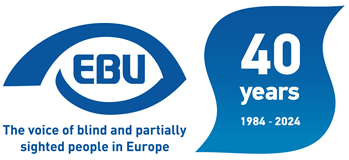A. LEGISLATION
1. What legislative measures are being taken in your country to facilitate the mobility of people with disabilities in general? (Accessibility of roads, transport, buildings) when should they apply?
- Regulation of Ministry of environment 532/2002 about general technical requirements for construction and technical requirements for buildings used by persons with limited mobility and orientation
- Act no. 447/2008 about cash benefits on compensation of severe disability
- Regulations of EC in the field of transport (EC 1107/2006, 1371/2007, 181/2011) and their implementation in relevant national legislation
The above mentioned legislation has already been applied.
2. Are there specific measures for the visually impaired? If so, describe them briefly.
According to the regulation 532/2002 there are defined tactile and colour markings and other measures concerning pavements, start and end of stairs, ramps, obstacles on pavements, entrances to important public buildings, crossings for pedestrians, acoustic traffic lights, platforms and stops, control panels and voice systems in lifts etc.
3. How are these measures implemented? Are visually impaired Associations associated with their application? If so, how?
Implementation is only partial.
The Slovak Blind and Partially Sighted Union (UNSS) provides audits of projects documentation, participates on final building approvals, counselling and training. It is gradually voluntarily accepted by construction authorities- some of them requires its statements in official approval processes.
4. Have they already produced tangible results?
Yes
5. What are the penalties for non-application of the above measures?
Penalties are not applied yet. There delays to final building approvals till required measures are applied.
B. TRAVEL AID
6. What are the main technical aids used by visually impaired people in your country for mobility: long cane, optical aids, electronic aids, GPS?
Long canes, optical aids (telescopes), electronic aids (ultrasonic locators), GPS systems in mobile telephones.
6.1. How are they distributed?
Long canes are provided by health aids providers, optical aids
Are provided by optics, electronic aids are distributed by distribution company Tyflocomp s.r.o. – private company established by UNSS.
6.2. Is training provided during their acquisition?
Yes, by UNSS
6.3. How are they funded in the acquisition?
Long canes and optical aids are funded by health insurance on medical prescription with contribution of the client.
Electronic aids are funded by Labour, social affairs and family offices through the scheme defined by the act no. 447/2008.
6.4. How are guaranteed and financed repairs, maintenance?
Repairs maintenance of electronic aids is guaranteed through the same scheme as their funding.
6.5. Is the white cane recognized as a symbol of visual impairment? If yes, specify the conditions related to its attribution, sanctions in cases of abuse, specific provisions regarding its use.
Yes, by the Act 8/2009 about road transport the white cane is recognized as a symbol of a person with visual impairment. The act obliges all participants of the road transport to pay enhanced attention to those persons. Other functions and parameters of white canes are not defined by legislation. Sanctions are not defined, but, in case of accident the above mentioned statement of the act is taken in account.
7. Is research conducted in your country to develop new assistive devices? If yes, please specify. How are visually impaired people associated with this research?
Yes, but in a very limited proportion (mainly software and mechanical braillers). Visually impaired people and their organizations participate on formulation on needs, testing and sometimes on development (mainly software and its localization).
C. LOCOMOTION TRAINING
8. How are visually impaired people in your country trained in mobility? (Specify training in the regular school or specialized in functional rehabilitation for people who lose their sight as adults, in the context of structures for the elderly.)
Training is provided in special schools and in the state rehabilitation centre for adult visually impaired on residential base. UNSS provides mobility training to persons of all ages, including pupils, students and elderly. They are provided individually (one client – one instructor).
9. What is the training undertaken by mobility instructors? Is it recognized by an official certificate? If yes, specify briefly the content of the training. Is there any on-the-job training for mobility instructors?
Training of mobility instructors is provided by UNSS based on certificate of the Ministry of labour, social affairs and family according to the act 448/2008 about social services. It is mostly provided as on-the-job mobility training.
D. AUTONOMY IN DAILY LIFE
10. Help with daily life: how are the visually impaired in your country trained to be autonomous in daily life?
They are trained in special schools, in the rehabilitation centre for adult visually impaired and by UNSS (in individual training courses).
11. Is there specific support? If so by which professionals is it provided and in what context? What is the training of these professionals?
Specific support is provided in framework of the social rehabilitation by the above mentioned institutions. UNSS provides that support through its eight regional centres. It also trains professionals based on certificate provided by Ministry of labour, social affairs and family according to the Act 448/2008 about social services.
12. Does your country have training for instructors in autonomy? Is there a certificate recognized by the State?
Yes. The training provided by UNSS is based on certificate of Ministry of labour, social affairs and family according to the Act 448/2008 about social services.
E. PUBLIC INFORMATION AND PROFESSIONALS
13. Is the public informed of the mobility needs of visually impaired people? If yes, by whom and how.
Yes, mostly by UNSS (campaigns, public presentations, press and media).
14. Do professionals who interact with visually impaired people have any specific training or awareness training concerning visual impairment?
UNSS offers such trainings. In official education process of professionals it occurs in a very limited way, mainly for special teachers and exceptionally for social workers.

